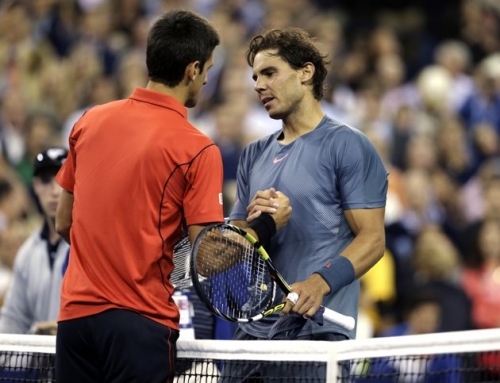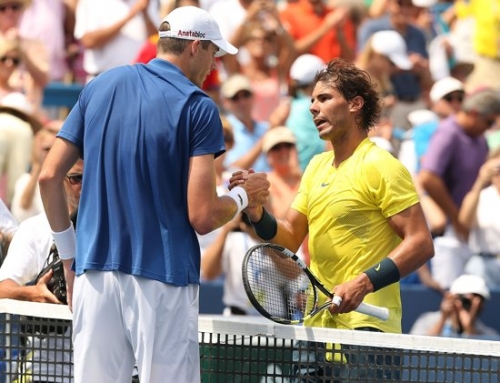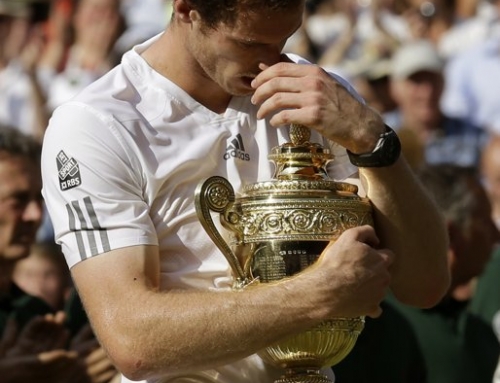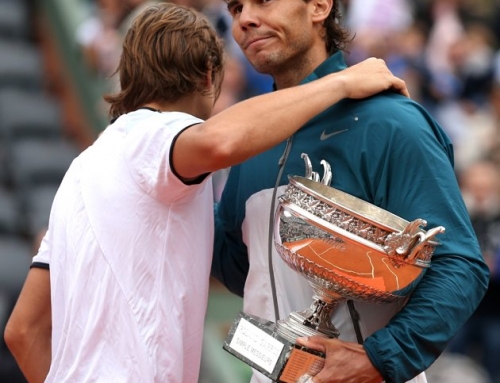 OK, this is a theory and may not be completely valid, but I think Djokovic’s transformation comes partly from learning how Davydenko beat Nadal. (For the curious, this was last year in London after a round-robin match. They swapped shirts like soccer teams often do).
OK, this is a theory and may not be completely valid, but I think Djokovic’s transformation comes partly from learning how Davydenko beat Nadal. (For the curious, this was last year in London after a round-robin match. They swapped shirts like soccer teams often do).
Up to Davydenko, the way to beat Nadal was to outhit him. Djokovic came closest to beating Nadal using his normal strategy. del Potro used his big forehand and big serve to overpower Nadal. Federer would go for high risk shots and look to use his powerful forehand to open the court. Murray would hit short crosscourt forehands to the Nadal backhand and look for the mid-court shot to hit hard inside-out to Nadal’s forehand.
Davydenko is not a big guy like del Potro or even Andy Murray. Murray likes to play way back from the baseline. However, Davydenko is like the successor to Agassi. He plays close to the baseline or inside the baseline. He has quick hands. At the end of 2009 and the start of 2010, he hit pay dirt with his game. He would use the angles to push Nadal back and open the court up to hit a down-the-line backhand.
But the key to Davydenko’s game is the angles. Sometimes his opponents use the angles against him, but Nadal plays a bit more conservative and would hit a heavy topspin shot to a neutral spot on court which Davydenko would handle.
Djokovic doesn’t quite use angles in the same way, but you can see how he’s added angles on the forehand and backhand to make his game very tough. He’s become a wall. Hit a hard shot to his forehand and Djokovic can hit a sharp angle back. This is almost the equivalent of what Agassi used to try against Sampras. He would hit a huge shot to Sampras’s forehand and Sampras would hit the reverse forehand with a sharper angle back. Djokovic used to have a tougher time dealing with a similar shot.
But now, Djokovic has the sharp angle forehand. With this, he became something of a brick wall. Federer was having a hard time hitting through Djokovic at the Australian Open, and was left wondering what to do. Normally, Federer goes in with a one-track mind. Play aggressive. Federer tried to mix it up by hitting high shots and changing pace. It worked for a while, but Federer went back to his aggressive strategy and couldn’t keep enough balls in play to win.
Nadal is also used to having players play way back to deal with his heavy topspin, but Djokovic no longer has to be afraid of this. He plays good angles, moves the ball around, and waits for the opening to hit a winner. Meanwhile, Nadal is left trying to figure out how to beat Djokovic. Djokovic is so good that he can win the long rallies against Nadal. Nadal pulls the trigger less than Djokovic so it’s usually Djokovic hitting the big shot, especially down-the-line, and yet it looks so controlled.
Maybe Djokovic found his own answers and Davydenko had little to do with his improved play. Maybe it’s the gluten-free diet. Maybe it’s the improved serve. But I think Djokovic’s ability to generate angles on both sides and to do so under duress is one thing that strikes me as similar to Davydenko, and that Djokovic is better at this game than Davydenko who is struggling with a new racquet (and is in Nadal’s section of the draw–he needs to win one more match, as does Nadal, to meet one another).




![[US Open Men’s Final] Can Djokovic beat Nadal in the finals?](https://www.essentialtennis.com/wp-content/uploads/2013/09/20130909djokovic-500x383.jpg)


